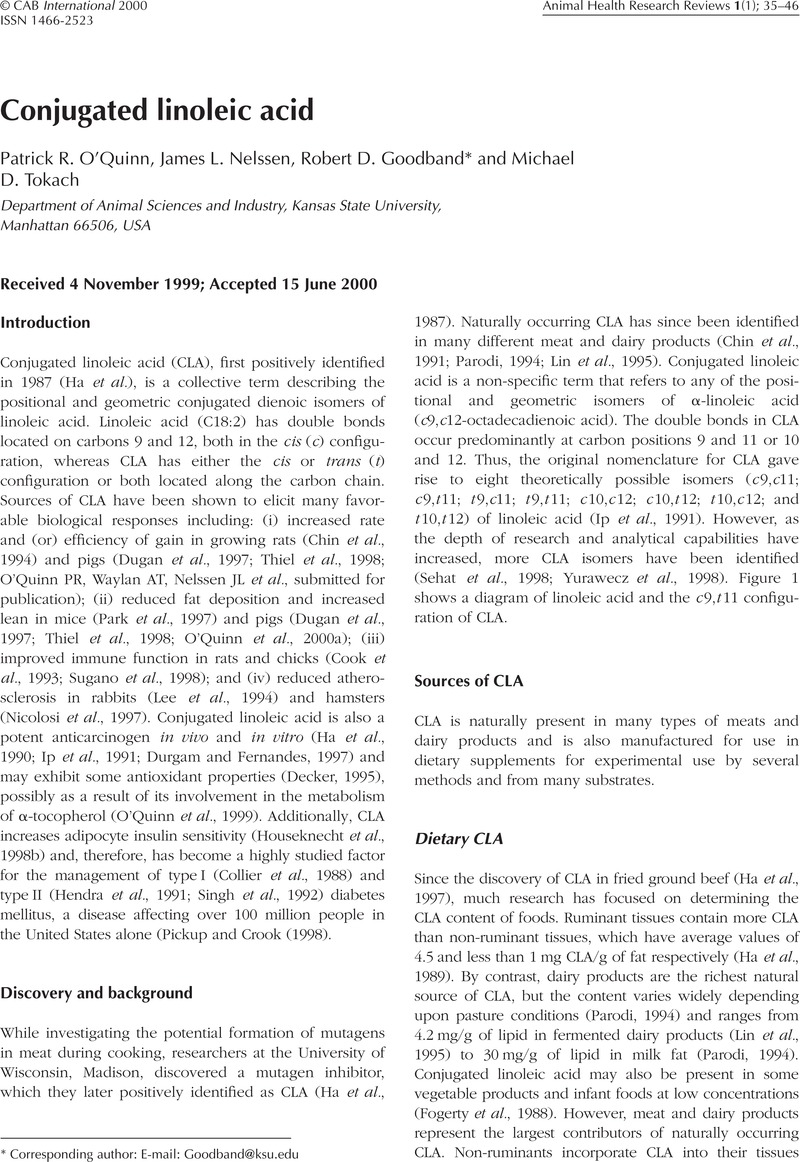Crossref Citations
This article has been cited by the following publications. This list is generated based on data provided by Crossref.
Blecha, Frank
2001.
Immunomodulators for Prevention and Treatment of Infectious Diseases in Food-Producing Animals.
Veterinary Clinics of North America: Food Animal Practice,
Vol. 17,
Issue. 3,
p.
621.
Bernas, Andreas
Kumar, Narendra
Mäki-Arvela, Päivi
Kul’kova, Natalya V
Holmbom, Bjarne
Salmi, Tapio
and
Murzin, Dmitry Yu
2003.
Isomerization of linoleic acid over supported metal catalysts.
Applied Catalysis A: General,
Vol. 245,
Issue. 2,
p.
257.
Bernas, Andreas
Mäki-Arvela, Päivi
Kumar, Narendra
Holmbom, Bjarne
Salmi, Tapio
and
Murzin, Dmitry Yu.
2003.
Heterogeneously Catalytic Isomerization of Linoleic Acid over Supported Ruthenium Catalysts for Production of Anticarcinogenic Food Constituents.
Industrial & Engineering Chemistry Research,
Vol. 42,
Issue. 4,
p.
718.
Bernas, Andreas
Kumar, Narendra
Mäki-Arvela, Päivi
Holmbom, Bjarne
Salmi, Tapio
and
Murzin, Dmitry Yu.
2004.
Heterogeneous Catalytic Production of Conjugated Linoleic Acid.
Organic Process Research & Development,
Vol. 8,
Issue. 3,
p.
341.
Bernas, Andreas
Kumar, Narendra
Laukkanen, Pekka
Väyrynen, Juhani
Salmi, Tapio
and
Murzin, Dmitry Yu
2004.
Influence of ruthenium precursor on catalytic activity of Ru/Al2O3 catalyst in selective isomerization of linoleic acid to cis-9,trans-11- and trans-10,cis-12-conjugated linoleic acid.
Applied Catalysis A: General,
Vol. 267,
Issue. 1-2,
p.
121.
Kreich, Markus
and
Claus, Peter
2005.
Direkte Umsetzung von Linolsäure an Silber‐Katalysatoren in Gegenwart von H2: ein ungewöhnlicher Weg zu konjugierten Linolsäuren.
Angewandte Chemie,
Vol. 117,
Issue. 47,
p.
7979.
Bernas, Andreas
and
Murzin, Dmitry Yu.
2005.
Linoleic acid isomerization on Ru/Al2O3 catalyst.
Chemical Engineering Journal,
Vol. 115,
Issue. 1-2,
p.
13.
Kreich, Markus
and
Claus, Peter
2005.
Direct Conversion of Linoleic Acid over Silver Catalysts in the Presence of H2: An Unusual Way towards Conjugated Linoleic Acids.
Angewandte Chemie International Edition,
Vol. 44,
Issue. 47,
p.
7800.
Murzin, D. Y.
Mäki‐Arvela, P.
Salmi, T.
and
Holmbom, B.
2007.
Catalytic Transformations for Production of Fine Chemicals and Pharmaceuticals from Wood‐Derived Raw Materials.
Chemical Engineering & Technology,
Vol. 30,
Issue. 5,
p.
569.
Mäki‐Arvela, Päivi
Holmbom, Bjarne
Salmi, Tapio
and
Murzin, Dmitry Yu.
2007.
Recent Progress in Synthesis of Fine and Specialty Chemicals from Wood and Other Biomass by Heterogeneous Catalytic Processes.
Catalysis Reviews,
Vol. 49,
Issue. 3,
p.
197.
Simakova, Olga A.
Leino, Anne-Riikka
Campo, Betiana
Mäki-Arvela, Päivi
Kordás, Krisztián
Mikkola, Jyri-Pekka
and
Murzin, Dmitry Yu.
2010.
Linoleic acid isomerization over mesoporous carbon supported gold catalysts.
Catalysis Today,
Vol. 150,
Issue. 1-2,
p.
32.
Philippaerts, An
Goossens, Steven
Jacobs, Pierre A.
and
Sels, Bert F.
2011.
Catalytic Production of Conjugated Fatty Acids and Oils.
ChemSusChem,
Vol. 4,
Issue. 6,
p.
684.
Passarini Junior, José Roberto
Gaspi, Fernanda Oliveira de Gaspari de
Neves, Lia Mara Grosso
Esquisatto, Marcelo Augusto Marreto
Santos, Gláucia Maria Tech dos
and
Mendonça, Fernanda Aparecida Sampaio
2012.
Application of Jatropha curcas L. seed oil (Euphorbiaceae) and microcurrent on the healing of experimental wounds in Wistar rats.
Acta Cirurgica Brasileira,
Vol. 27,
Issue. 7,
p.
441.
Cardó, Xavier
Bergadà, Olga
Cesteros, Yolanda
and
Salagre, Pilar
2012.
Effect of catalyst acidity and porosity on the catalytic isomerization of linoleic acid to obtain conjugated linoleic acids (CLAs).
Chemical Engineering Journal,
Vol. 183,
Issue. ,
p.
459.
Bandzar, Sean
Gupta, Shabnam
and
Platt, Manu O.
2013.
Crohn’s disease: A review of treatment options and current research.
Cellular Immunology,
Vol. 286,
Issue. 1-2,
p.
45.
He, Xihong
Shang, Jiling
Li, Fan
and
Liu, Hao
2015.
Yeast cell surface display of linoleic acid isomerase from Propionibacterium acnes and its application for the production of trans‐10, cis‐12 conjugated linoleic acid.
Biotechnology and Applied Biochemistry,
Vol. 62,
Issue. 1,
p.
1.
Pongket, Urailuck
Piyatheerawong, Weera
Thapphasaraphong, Suthasinee
and
H-Kittikun, Aran
2015.
Enzymatic preparation of linoleic acid from sunflower oil: an experimental design approach.
Biotechnology & Biotechnological Equipment,
Vol. 29,
Issue. 5,
p.
926.
Oz, Fatih
and
Cakmak, Isa Han
2016.
The effects of conjugated linoleic acid usage in meatball production on the formation of heterocyclic aromatic amines.
LWT,
Vol. 65,
Issue. ,
p.
1031.
Song, Kibbeum
Song, In-Bong
Gu, Hye-Jung
Na, Ji-Young
Kim, Sokho
Yang, Hee-Sun
Lee, Sang-Cheon
Huh, Chang-Ki
and
Kwon, Jungkee
2016.
Anti-diabetic Effect of Fermented Milk Containing Conjugated Linoleic Acid on Type II Diabetes Mellitus.
Korean Journal for Food Science of Animal Resources,
Vol. 36,
Issue. 2,
p.
170.
Garibay-Nieto, Nayely
Queipo-García, Gloria
Alvarez, Flor
Bustos, Mayra
Villanueva, Erendira
Ramírez, Fernando
León, Mireya
Laresgoiti-Servitje, Estibalitz
Duggirala, Ravindranath
Macías, Teresa
Cuevas, Sergio
Jalife, Abel
Fonseca-Sánchez, Miguel
Serratos, Fabiola
and
López-Alvarenga, Juan Carlos
2017.
Effects of Conjugated Linoleic Acid and Metformin on Insulin Sensitivity in Obese Children: Randomized Clinical Trial.
The Journal of Clinical Endocrinology & Metabolism,
Vol. 102,
Issue. 1,
p.
132.



